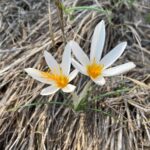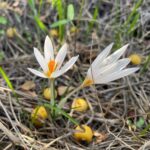Αρκοσσιυλλί, Κρόκος της Αφροδίτης
Etymology of Crocus veneris: The name of the genus, "Crocus", derives from the Ancient Greek word "κρόκος", which is alleged of a Semitic origin. Latin borrowed this word, which received the meaning of the yolk, obviously due to the yellow color of the centre of this genus's flowers (stamens and pistil). Latin "veneris" is translated as "of Aphrodite", since Crocus veneris is an endemic plant of Cyprus, the birthplace of Aphrodite (Venus), hence "veneris".
There are three Crocus species/kinds in the wild Cypriot habitat.
Crocus, according to ancient Greek mythology, was a friend of the god Hermes. One day while the two friends were playing, Hermes accidentally hit Crocus on the head and killed him. Where this event took place a flower grew. Three drops of the unfortunate young man's blood fell into the center of the flower and gave the spots to the initial species which has since taken the name Crocus. A second myth refers to the unrequited love of a young man, Crocus, for the nymph Smilaka which led to his transformation into the eponymous plant.
Crocus veneris has white (to pink) flowers. Its height is only 8 cm. It blooms around the middle of October until November. We find it in stony and grassy habitats and in limestone rocks' open pine forests. Even though it is a rare occurrence to encounter a Crocus plant in Cyprus, Crocus veneris is found almost all over the island, but mainly in Kato Paphos, Agios Neophytos Monastery area, in Statos-Agios Fotios village and surrounding areas (Paphos district), in the area of Prophitis Ilias in Lythrodontas village (Nicosia district), in Akrotiri village (Limassol district), in Kornos village (Larnaca district), and of course in other not that popular locations. This plant grows between an altitude of 100-925 metres.
How to find Crocus veneris in Cyprus:
The specimens of the pictures were found in Pentalia village (Paphos district), literally on the borders with the village of Galataria, at an elevation of approximately 700 metres. On the right turn towards Galataria from the main road, there is another turn on the right that heads towards the old village of Pentalia (there is an old and a new Pentalia village). Between those two asphalt roads, there is a third dirt road. Take the dirt road and keep driving straight for approximately 300 metres and a Crocus veneris colony exists on the right side below the first olive tree that you will see next to the road.




